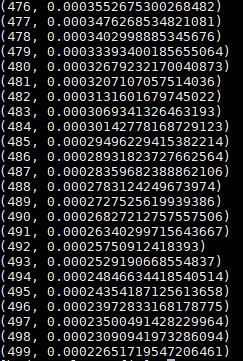PyTorch是使用GPU和CPU优化的深度学习张量库。
1、安装,参考官网:http://pytorch.org/
conda install pytorch torchvision -c pytorch2、认识,参考:
https://github.com/yunjey/pytorch-tutorial
https://github.com/jcjohnson/pytorch-examples
http://pytorch-cn.readthedocs.io/zh/latest/
3、demo:
# Code in file tensor/two_layer_net_tensor.py
import torch
dtype = torch.FloatTensor
# dtype = torch.cuda.FloatTensor # Uncomment this to run on GPU
# N is batch size; D_in is input dimension;
# H is hidden dimension; D_out is output dimension.
N, D_in, H, D_out = 64, 1000, 100, 10
# Create random input and output data
x = torch.randn(N, D_in).type(dtype)
y = torch.randn(N, D_out).type(dtype)
# Randomly initialize weights
w1 = torch.randn(D_in, H).type(dtype)
w2 = torch.randn(H, D_out).type(dtype)
learning_rate = 1e-6
for t in range(500):
# Forward pass: compute predicted y
h = x.mm(w1)
h_relu = h.clamp(min=0)
y_pred = h_relu.mm(w2)
# Compute and print loss
loss = (y_pred - y).pow(2).sum()
print(t, loss)
# Backprop to compute gradients of w1 and w2 with respect to loss
grad_y_pred = 2.0 * (y_pred - y)
grad_w2 = h_relu.t().mm(grad_y_pred)
grad_h_relu = grad_y_pred.mm(w2.t())
grad_h = grad_h_relu.clone()
grad_h[h < 0] = 0
grad_w1 = x.t().mm(grad_h)
# Update weights using gradient descent
w1 -= learning_rate * grad_w1
w2 -= learning_rate * grad_w2
而同样np跑出来的结果是:
代码如下:
# Code in file tensor/two_layer_net_numpy.py
import numpy as np
# N is batch size; D_in is input dimension;
# H is hidden dimension; D_out is output dimension.
N, D_in, H, D_out = 64, 1000, 100, 10
# Create random input and output data
x = np.random.randn(N, D_in)
y = np.random.randn(N, D_out)
# Randomly initialize weights
w1 = np.random.randn(D_in, H)
w2 = np.random.randn(H, D_out)
learning_rate = 1e-6
for t in range(500):
# Forward pass: compute predicted y
h = x.dot(w1)
h_relu = np.maximum(h, 0)
y_pred = h_relu.dot(w2)
# Compute and print loss
loss = np.square(y_pred - y).sum()
print(t, loss)
# Backprop to compute gradients of w1 and w2 with respect to loss
grad_y_pred = 2.0 * (y_pred - y)
grad_w2 = h_relu.T.dot(grad_y_pred)
grad_h_relu = grad_y_pred.dot(w2.T)
grad_h = grad_h_relu.copy()
grad_h[h < 0] = 0
grad_w1 = x.T.dot(grad_h)
# Update weights
w1 -= learning_rate * grad_w1
w2 -= learning_rate * grad_w2根据实际应用场景,后续可深入学习,重点是gpu了。




























 121
121

 被折叠的 条评论
为什么被折叠?
被折叠的 条评论
为什么被折叠?








